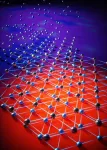(Press-News.org) CHAMPAIGN, Ill. -- The chance of detecting the virus that causes COVID-19 increases with more frequent testing, no matter the type of test, a new study found. Both polymerase chain reaction and antigen tests, paired with rapid results reporting, can achieve 98% sensitivity if deployed at least every three days.
"This study shows that frequent testing can be really effective at catching COVID-19 infections and potentially blocking transmission," said study leader Christopher Brooke, a virologist and professor of microbiology at the University of Illinois Urbana-Champaign. "There are many places where vaccination is not yet widespread. With the rise of variants, testing remains an important tool for blocking the spread of the virus."
Part of the Rapid Acceleration of Diagnostics Tech program of the National Institutes of Health, the study brought together researchers at Illinois; the University of Massachusetts Medical School, Worcester; Johns Hopkins School of Medicine, Baltimore; and the NIH National Institute of Biomedical Imaging and Bioengineering. The researchers published their results in the Journal of Infectious Diseases.
Students and employees at the U. of I. who had tested positive for COVID-19 or were identified as close contacts of a person who tested positive were invited to participate. Because of the SHIELD Illinois screening program, which required students and employees to take multiple saliva-based tests each week and returned results in less than 24 hours, the university provided an ideal location for identifying cases before they became symptomatic, the researchers said.
The 43 study participants received three tests daily for 14 days: a PCR nasal swab, a PCR saliva test and an antigen nasal swab. The results of each were compared with live viral cultures taken from the PCR nasal swab, which show when a person is actively infectious. The study also examined how the frequency of testing affected each method's efficacy at detecting an infection.
"Different tests have different advantages and limitations. Antigen tests are fast and cheap, but they are not as sensitive as PCR tests. PCR are the gold standard, but they take some time to return results and are more expensive," said Rebecca Lee Smith, a professor of epidemiology at Illinois and the first author of the study. "This study was to show, based on real data, which test is best under which circumstances and for what purpose."
The results showed that the PCR tests - particularly saliva-based ones - were best at detecting cases before the person had an infectious viral load, a key to isolating individuals before they can spread the virus, Smith said. For all three methods, testing every three days had 98% sensitivity to detecting infection.
If that testing frequency declined to once a week, the PCR methods maintained their high sensitivity but the antigen tests dropped to around 80%. That means organizations that wish to deploy antigen testing as part of a reopening strategy or individuals who wish to monitor their status at home should use antigen tests multiple times each week to achieve similar results to PCR testing, the researchers said.
"This work also shows how the PCR and antigen tests could be used in combination," Smith said. "For example, I work with a lot of school districts, helping them to plan for fall, since vaccines are not yet available to those under 12 years old. If a student had a known exposure or comes to school symptomatic, give them both tests. Antigen tests are really good at finding those highly infectious people, so that can tell administrators right away if the child needs to be sent home, rather than waiting 24 hours for PCR results. If the antigen test is negative, the PCR test is a backup, as it may detect the infection earlier than an antigen test would, before the student becomes contagious."
The results of the study helped inform the U.S. Food and Drug Administration's recommendations and instructions on how to use at-home antigen tests that recently received emergency use authorization. The researchers said they hope the results assist schools, businesses and other organizations as they reopen.
"If you are in a situation where you have the resources and capacity to do large-scale PCR testing with rapid results reporting like we did here at Illinois, you can identify infections early and potentially isolate people before they become contagious," Brooke said. "In places where PCR testing is not readily available or rapid results reporting is not possible, but the cheaper and more rapid tests are available, our data show how those tests can be deployed in a way that can increase their sensitivity - through repeated serial testing, ideally three times a week or more."
INFORMATION:
The study was conducted with support from the NIH RADx-Tech program under grant U54 HL143541-02S2.
Editor's notes: To reach Christopher Brooke, email cbrooke@illinois.edu. To reach Rebecca Smith, email rlsdvm@illinois.edu.
The paper "Longitudinal assessment of diagnostic test performance over the course of acute SARS-CoV-2 infection" is available online. DOI:10.1093/jid/jiab337
QUT researchers have developed a new machine learning mathematical system that helps to identify and detect changes in biodiversity, including land clearing, when satellite imagery is obstructed by clouds.
Using statistical methods to quantify uncertainty, the research, published in Remote Sensing in Ecology and Conservation, analysed available satellite images of an 180km square area in central south-east Queensland.
The region is home to many native species including the critically endangered northern hairy-nosed wombat and the vulnerable greater glider, and the ...
Fossilized feces are common finds at paleontological dig sites and might actually contain hidden treasures. By scanning fossilized dung assigned to a close dinosaur relative from the Triassic period, scientists discovered a 230-million-year-old beetle species, representing a new family of beetles, previously unknown to science. The beetles were preserved in a 3D state with their legs and antennae fully intact. The finding appears June 30 in the journal Current Biology.
The discovery that fossilized droppings, also known as coprolites, can preserve ancient insect species offers a new alternative to amber fossils--fossilized tree resin, which normally yield the best-preserved insect fossils. The oldest ...
Don't let the great snipe's pudginess fool you. A stocky marsh bird with a 20-inch wingspan, great snipes are also speedy marathoners that can migrate from Sweden to Central Africa in just three days, without even stopping to eat, drink, or sleep. Now, researchers find that the snipes also rise nearly 2,500 meters in elevation at dawn and descend again at dusk each day, perhaps to avoid overheating from daytime solar radiation by climbing to higher, cooler altitudes. The findings appear June 30 in the journal Current Biology.
The birds also spent much more time in higher elevations ...
Election outcomes are notoriously difficult to predict. In 2016, for example, most polls suggested that Hillary Clinton would win the presidency, but Donald Trump defeated her. Researchers cite multiple explanations for the unreliability in election forecasts -- some voters are difficult to reach, and some may wish to remain hidden. Among those who do respond to surveys, some may change their minds after being polled, while others may be embarrassed or afraid to report their true intentions.
In a new perspective piece for END ...
30 June 2021: A large cohort study drawn from the national IVF registry of France, which included almost 70,000 pregnancies delivered after 22 weeks gestation between 2013 and 2018, has found a higher risk of pre-eclampsia and hypertension in pregnancies derived from frozen-thawed embryos. This risk was found significantly greater in those treatments in which the uterus was prepared for implantation with hormone replacement therapies. The results confirm with real-life data what has been observed in sub-groups of patients in other studies.
The results are presented today by Dr Sylvie Epelboin from the Hôpital Bichat-Claude Bernard, Paris, at the online annual meeting of ESHRE. The study was performed on behalf ...
The tiny beetle Triamyxa coprolithica is the first-ever insect to be described from fossil faeces. The animal the researchers have to thank for the excellent preservation was probably the dinosaur ancestor Silesaurus opolensis, which 230 million years ago ingested the small beetle in large numbers.
In a recently published study in Current Biology, vertebrate palaeontologists from Uppsala University and entomologists from National Sun Yat-sen University (Taiwan), Friedrich-Schiller-Universität Jena (Germany), and Universidad de Guadalajara (Mexico) used synchrotron microtomography to 3D-reconstruct the beetles while they were still trapped within the fossilised faecal matter. The coprolite contained abundant beetle body parts, most belonging to ...
Harpy eagles (Harpia harpyja) - which are among the world's largest eagle species - struggle to feed offspring in heavily deforested areas of the Amazon, according to a study published in Scientific Reports.
Everton Miranda and colleagues found that harpy eagles rely on specific prey that lives in canopy forests, including sloths and monkeys. Eaglets starved in areas of high deforestation where canopy-based food was limited.
The authors observed prey species, how frequently prey was delivered, and estimated the weight of prey in 16 harpy eagle nests in Amazonian forests in Mato ...
ROCKVILLE, MD, USA - June 30, 2021 - Researchers from Sanaria® Inc. and the National Institutes of Health (NIH) are making progress in the development of highly protective malaria vaccines.
In an article published today in Nature, Sanaria's PfSPZ-CVac (CQ) vaccine is reported as being safe and protecting 100% of six subjects against a variant malaria parasite three months after their last dose in the company's Phase 1 safety and efficacy trial. This is the first time complete protection against a variant malaria parasite has ever been achieved that long after vaccine administration.
The ...
Many neurodevelopmental disorders share similar symptoms, such as learning disabilities or attention deficits. A new study from MIT has uncovered a common neural mechanism for a type of cognitive impairment seen in some people with autism and schizophrenia, even though the genetic variations that produce the impairments are different for each condition.
In a study of mice, the researchers found that certain genes that are mutated or missing in some people with those disorders cause similar dysfunctions in a neural circuit in the thalamus. If scientists could develop drugs that target this circuit, they could be used to treat people who have different disorders with common behavioral ...
In 1934, physicist Eugene Wigner made a theoretical prediction based on quantum mechanics that for 87 years went unseen.
The theory suggested how a metal that normally conducts electricity could turn into a nonconducting insulator when the density of electrons is reduced. Wigner theorized that when electrons in metals are brought to ultracold temperatures, these electrons would be frozen in their tracks and form a rigid, non-electricity conducting structure -- a crystal -- instead of zipping around at thousands of kilometers per second and creating an electric current. Since he discovered it, the ...




